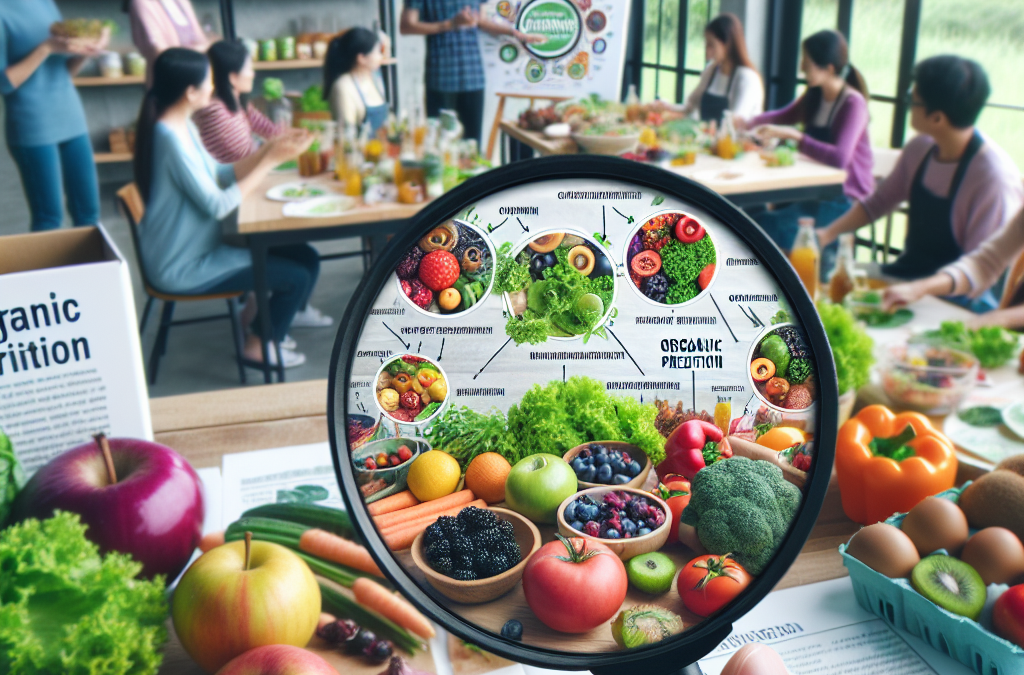Table of Contents
- Introduction to Whole Food Fiber
- What Is Whole Food Fiber? Definitions and Benefits
- 10 Effective Tips for Incorporating Whole Food Fiber in Your Diet (2025)
- Tip 1: Start Your Day with High-Fiber Breakfasts
- Tip 2: Choose Whole Grain Options for Snacks and Meals
- Tip 3: Incorporate Legumes and Beans Regularly
- Tip 4: Add Vegetables to Every Meal
- Tip 5: Opt for Fruits with Pearls of Fiber
- Tip 6: Use Seeds and Nuts as Fiber Boosters
- Tip 7: Read Food Labels Carefully for Fiber Content
- Tip 8: Experiment with Fiber Supplements When Needed
- Tip 9: Stay Hydrated to Maximize Fiber Benefits
- Tip 10: Track Your Fiber Intake for Optimal Health
- FAQs about Whole Food Fiber in 2025
- Conclusion: Embracing Whole Food Fiber for Better Health in 2025
1. Introduction to Whole Food Fiber
Understanding the Role of Fiber in Nutrition
Fiber is a vital component of a balanced diet that supports digestive health and overall well-being. In 2025, more health-conscious individuals are turning to *whole food fiber* as a natural way to improve their diet. Unlike processed fiber supplements, whole food fiber comes directly from natural foods, providing additional nutrients and antioxidants. Consuming a variety of fiber-rich foods can help manage weight, promote regularity, and lower the risk of chronic diseases.
Whole food fiber is found in plant-based foods such as fruits, vegetables, grains, nuts, and legumes. These foods contain both soluble and insoluble fiber, each offering distinct health benefits. Soluble fiber dissolves in water, forming a gel-like substance that can help lower cholesterol levels. Insoluble fiber adds bulk to stool, aiding in digestion and preventing constipation.
Incorporating whole food fiber into your diet is easy and tasty once you know what foods to include. In this guide, Iâll share practical tips and insights that will help you maximize your fiber intake naturally, especially in 2025 where dietary trends lean heavily toward whole, minimally processed foods.
2. What Is Whole Food Fiber? Definitions and Benefits
The Definition of Whole Food Fiber
Whole food fiber refers to the dietary fiber naturally present in unprocessed or minimally processed plant foods. It differs from isolated or synthetic fiber supplements, offering a full spectrum of fibers along with phytochemicals, vitamins, and minerals. Whole food fiber enhances the nutritional profile of meals and contributes to overall health.
Health Benefits of Whole Food Fiber
Research in 2025 continues to support the numerous benefits of consuming whole food fiber. It helps regulate blood sugar levels, improves digestive health, and aids weight control. Additionally, whole food fiber supports the growth of beneficial gut bacteria, which play a crucial role in immune function and mental health. Regular consumption is linked to a lower risk of heart disease, type 2 diabetes, and certain types of cancer.
Incorporating a variety of fiber-rich foods from natural sources makes your diet more diverse and nutrients more bioavailable. The emphasis on whole food fiber aligns with current health trends that favor whole, unprocessed foods for optimal well-being.
3. 10 Effective Tips for Incorporating Whole Food Fiber in Your Diet (2025)
4. Tip 1: Start Your Day with High-Fiber Breakfasts
Why Breakfast Sets the Tone for Your Fiber Intake
Starting your day with a fiber-rich breakfast can significantly boost your daily intake. Foods like oatmeal, whole grain cereals, and smoothies with added fruits and nuts are excellent choices. In 2025, breakfast options emphasizing whole food fiber are more popular than ever, especially with the rise of healthy snack bars and quick-prepare options that are minimally processed.
If youâre in a rush, prepping overnight oats with chia seeds and berries is a simple way to ensure your morning is fiber-packed. This habit not only provides sustained energy but also improves digestion throughout the day.
Practical Tips for a Fiber-Rich Morning Meal
- Use rolled oats or steel-cut oats instead of refined cereals.
- Add a handful of nuts or seeds to increase fiber and healthy fats.
- Include fresh or frozen fruits like berries, sliced apples, or bananas for extra fiber and flavor.
Making simple swaps in your breakfast routine can lead to noticeable improvements in digestion and overall health as endorsed by current dietary guidelines.
5. Tip 2: Choose Whole Grain Options for Snacks and Meals
Identifying Whole Grains in Your Diet
Whole grains are a cornerstone of a high-fiber diet. When shopping in 2025, look for products labeled â100% whole grainâ or âwhole wheat,â as these contain all parts of the grain, including the bran, germ, and endosperm. Common whole grains include brown rice, quinoa, barley, oats, and bulgur. Replacing refined grains with whole grains increases your fiber intake significantly.
Meal Ideas Featuring Whole Food Whole Grains
Prepare hearty salads with cooked quinoa or barley, serve whole-grain bread instead of white bread, and choose brown rice over white rice. These small changes can boost your daily fiber intake while adding variety to your meals.
Research indicates that consuming whole grains regularly reduces the risk of cardiovascular disease and type 2 diabetes, especially when combined with other healthy lifestyle habits. Incorporating whole grains is an effective, sustainable strategy for better health.
6. Tip 3: Incorporate Legumes and Beans Regularly
Legumes as a Powerhouse of Whole Food Fiber
Legumes, including lentils, chickpeas, black beans, and kidney beans, are exceptional sources of dietary fiber. In 2025, they are increasingly recognized not only for their fiber content but also for their amino acids and micronutrients.
How to Add Legumes to Your Diet
Try adding lentils to soups, salads, and stews, or snacks on roasted chickpeas. Incorporating a variety of beans twice a week can dramatically increase your fiber intake and improve gut health. Additionally, theyâre budget-friendly and versatile ingredients that suit many cuisines.
Research links legume consumption with reduced inflammation and improved metabolic health, making them a smart choice for your daily diet.
7. Tip 4: Add Vegetables to Every Meal
Vegetables as Natural Sources of Whole Food Fiber
Most vegetables are high in fiber, especially those with edible skins, like carrots, cucumbers, and sweet potatoes. In 2025, the emphasis on vegetables continues to grow, with consumers seeking fresh, organic, and local sources to maximize nutrient intake.
Creative Ways to Include More Vegetables
Add spinach or kale into your smoothies, include roasted vegetables as side dishes, and load your sandwiches with crunchy greens. These small adjustments can significantly elevate your fiber intake without much effort.
Eating a diverse array of vegetables not only benefits your gut but also provides antioxidants that combat oxidative stress, contributing to long-term health benefits.
Huge Discount on the Best Certified Organic Whole Food Supplement!
8. Tip 5: Opt for Fruits with Pearls of Fiber
Fruits Rich in Dietary Fiber
Fruits like apples, pears, berries, and oranges contain high levels of fiber, especially when eaten with their skins. In 2025, focusing on whole fruits rather than processed fruit products ensures maximum fiber benefits.
Smart Fruit Choices for Your Diet
Keep fresh fruit accessible for snacks, add sliced fruit to cereals and yogurt, and experiment with dried fruits like apricots and figs sparingly due to their concentrated sugar content. These choices support digestive health and provide essential vitamins and minerals.
9. Tip 6: Use Seeds and Nuts as Fiber Boosters
Types of Seeds and Nuts Rich in Fiber
Chia seeds, flaxseeds, almonds, walnuts, and sunflower seeds are excellent sources of dietary fiber. In 2025, incorporating a handful of these into your meals or snacks is an easy way to increase whole food fiber intake.
Incorporating Seeds and Nuts into Your Diet
Add chia seeds to your oatmeal or smoothies, sprinkle flaxseed on salads, or enjoy a handful of nuts as a snack. They not only boost fiber but also provide healthy fats and protein.
Studies show that regular consumption of nuts and seeds can improve lipid profiles and reduce inflammation, enhancing your overall health.
10. Tip 7: Read Food Labels Carefully for Fiber Content
Tips for Choosing High-Fiber Foods
In 2025, understanding food labels is essential for maximizing whole food fiber intake. Look for products with at least 3 grams of fiber per serving and compare different brands to choose the best options.
Decoding Nutrition Labels Effectively
Pay attention to ingredient listsâwhole grains and fibrous foods list whole items like oats, bran, or millet first. Avoid heavily processed foods that claim âfiber-enrichedâ but contain added sugars and artificial ingredients.
11. Tip 8: Experiment with Fiber Supplements When Needed
When to Consider Fiber Supplements
While whole food sources are preferred, in some casesâlike busy lifestyles or certain health conditionsâfiber supplements can help bridge the gap. In 2025, choosing natural, minimally processed fiber supplements, like psyllium husk, can be beneficial.
Using Fiber Supplements Safely
Start slow to prevent digestive discomfort, and increase water intake to support fiberâs work in your gut. Consult a healthcare professional for personalized advice and use supplements as part of a balanced diet.
12. Tip 9: Stay Hydrated to Maximize Fiber Benefits
The Connection Between Water and Dietary Fiber
Proper hydration is essential for fiber to work efficiently. In 2025, new hydration guidelines recommend drinking at least 8 glasses of water daily, especially when increasing fiber intake. Water helps fiber move smoothly through your digestive system.
Tips for Staying Hydrated
Include water-rich foods like cucumbers and watermelon in your diet, carry a reusable water bottle, and set reminders to drink fluids throughout the day. Hydration supports metabolic functions and promotes healthy bowel movements.
13. Tip 10: Track Your Fiber Intake for Optimal Health
Monitoring Fiber Consumption
Using apps or journals to log your food intake helps you stay aware of your daily fiber consumption. In 2025, digital tools can provide detailed insights into not only fiber but overall nutrition.
Setting Realistic Goals
Start by aiming for the recommended 25-30 grams of fiber daily, adjusting as needed. Consistent tracking can motivate you to diversify your diet with nutrient-dense, whole food fiber sources.
Frequently Asked Questions about Whole Food Fiber in 2025
Q1: What is the best way to increase whole food fiber in my diet?
The most effective way is to include a variety of fiber-rich foods like fruits, vegetables, whole grains, nuts, and legumes daily. Small daily changes add up over time.
Q2: How much whole food fiber should I aim for each day in 2025?
The general recommendation is about 25-30 grams per day for adults. Adjust based on your health needs and consult with a nutritionist for personalized advice.
Q3: Can I get enough fiber from supplements alone?
While supplements can help, they shouldnât replace whole food sources. A diet rich in whole food fiber foods offers additional nutrients and health benefits that supplements cannot provide.
Q4: Why is whole food fiber better than processed fiber?
Whole food fiber provides a full spectrum of dietary fibers along with other beneficial compounds like vitamins, minerals, and phytochemicals. Processed fiber often lacks these additional nutrients and can be less beneficial overall.
Conclusion: Embracing Whole Food Fiber for Better Health in 2025
In conclusion, incorporating *whole food fiber* into your diet is one of the simplest and most effective ways to improve your health now and in 2025. From starting your morning with high-fiber breakfasts to reading labels carefully, each tip helps you make well-informed choices that support digestive health, weight management, and disease prevention. Remember, consistent intake and a balanced diet rich in natural, minimally processed foods will give you the best results. Make whole food fiber your ally for a healthier, happier life today!




